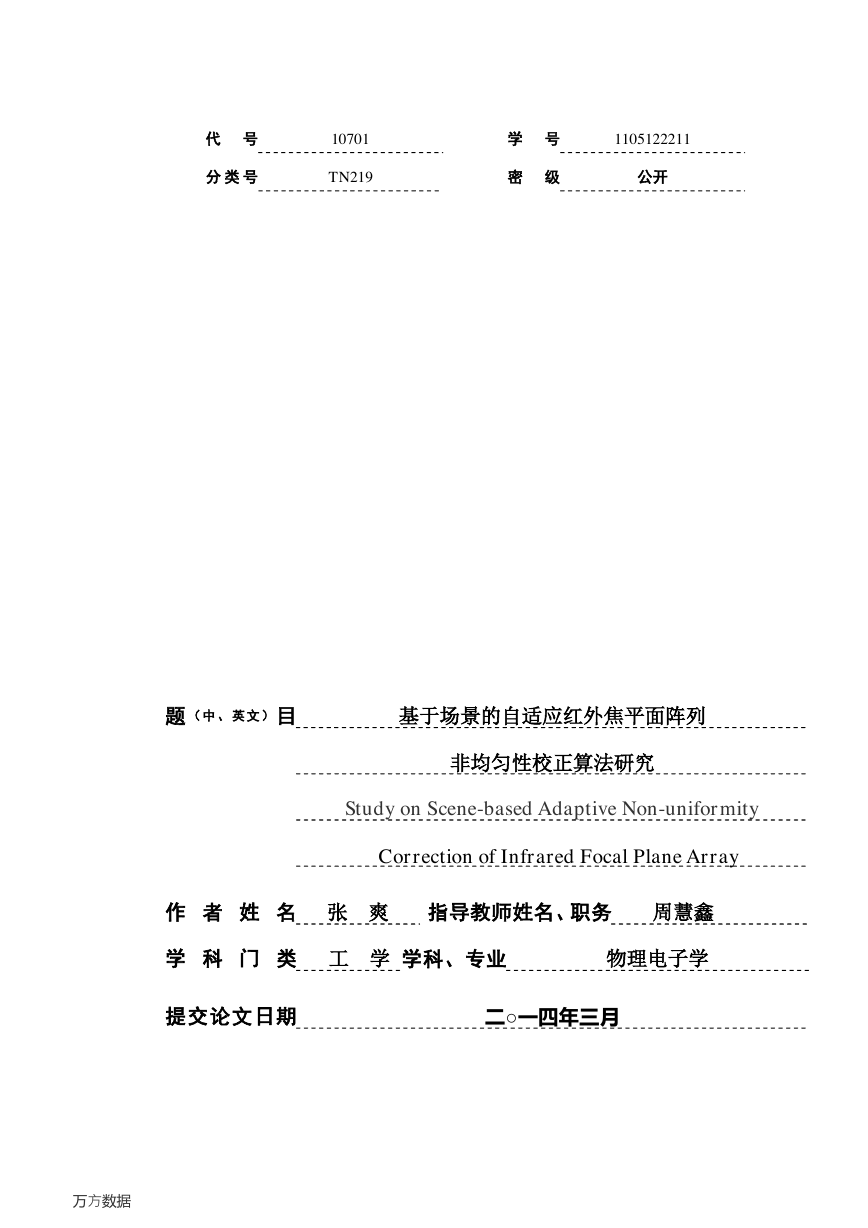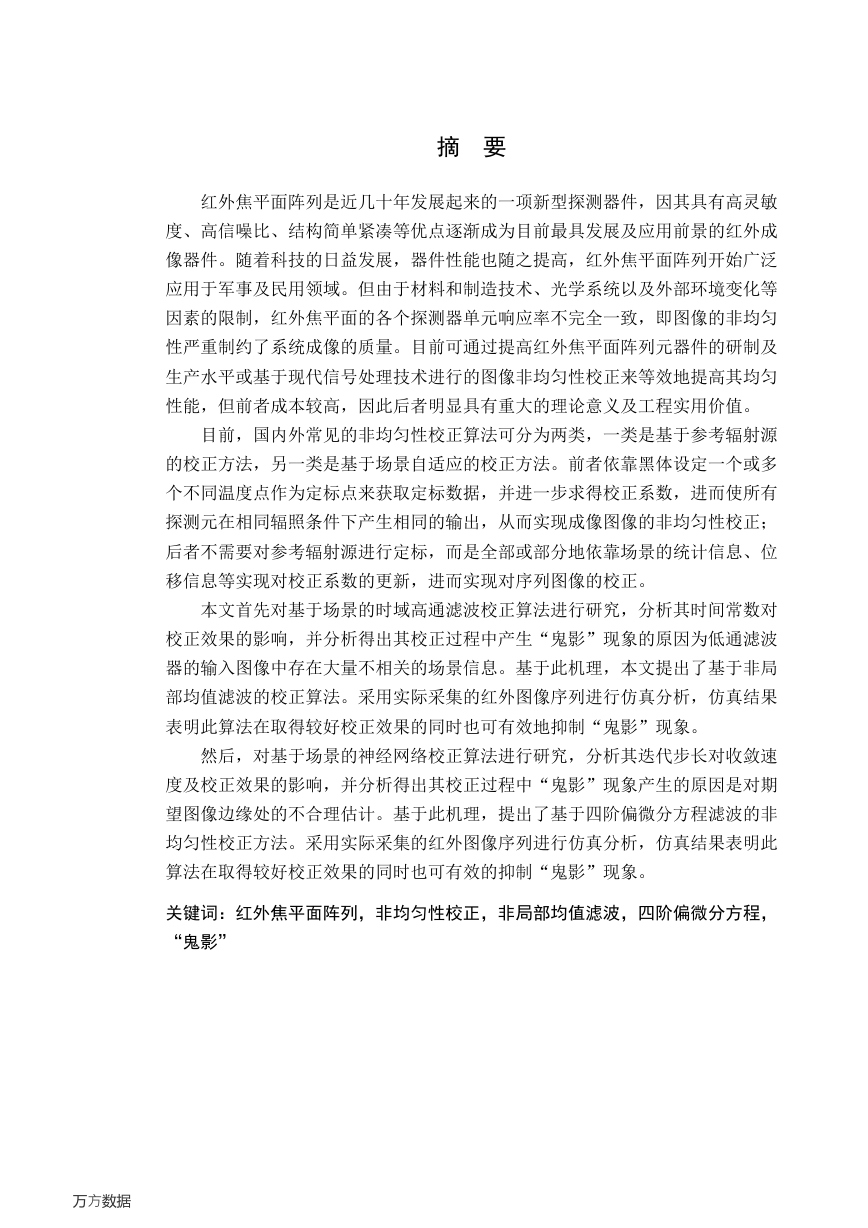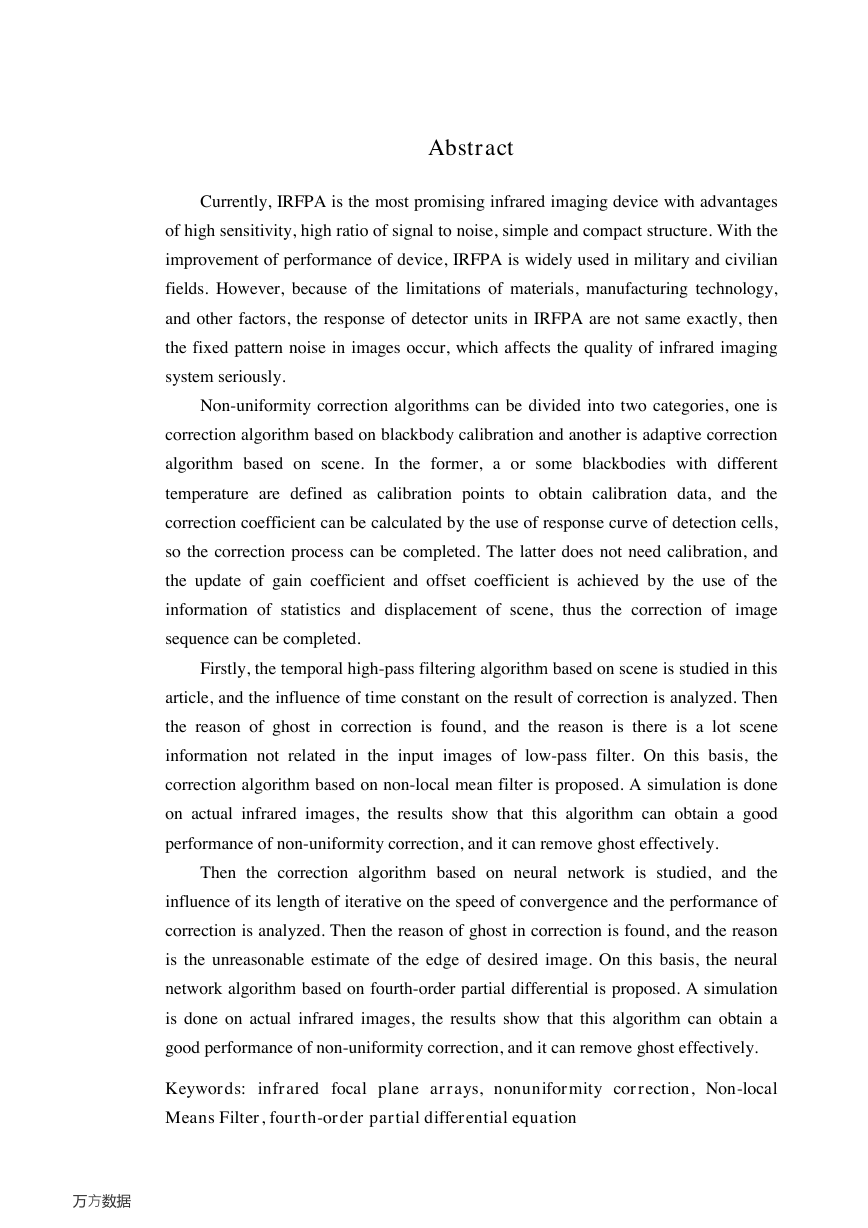代 号
分 类 号
10701
TN219
学 号
密 级
1105122211
公开
Correction of Infrared Focal Plane Array
基于场景的自适应红外焦平面阵列
学科、专业
非均匀性校正算法研究
Study on Scene-based Adaptive Non-uniformity
题 (中、 英文 ) 目
作 者 姓 名 张 爽 指导教师姓名、职务 周慧鑫
学 科 门 类 工 学
物理电子学
提交论文日期
二○一四年三月
˝
•
‰
˚
�
˝
•
‰
˚
�
西安电子科技大学
学位论文独创性(或创新性)声明
秉承学校严谨的学风和优良的科学道德,本人声明所呈交的论文是我个人在
导师指导下进行的研究工作及取得的研究成果。尽我所知,除了文中特别加以标
注和致谢中所罗列的内容以外,论文中不包含其他人已经发表或撰写过的研究成
果;也不包含为获得西安电子科技大学或其它教育机构的学位或证书而使用过的
材料。与我一同工作的同志对本研究所做的任何贡献均已在论文中做了明确的说
明并表示了谢意。
申请学位论文与资料若有不实之处,本人承担一切的法律责任。
本人签名: 日期:
西安电子科技大学
关于论文使用授权的说明
本人完全了解西安电子科技大学有关保留和使用学位论文的规定,即:研究
生在校攻读学位期间论文工作的知识产权单位属西安电子科技大学。学校有权保
留送交论文的复印件,允许查阅和借阅论文;学校可以公布论文的全部或部分内
容,可以允许采用影印、缩印或其它复制手段保存论文。同时本人保证,毕业后
结合学位论文研究课题再撰写的文章一律署名单位为西安电子科技大学。
(保密的论文在解密后遵守此规定)
本学位论文属于保密,在___年解密后适用本授权书。
本人签名: 日期:
导师签名: 日期:
˝
•
‰
˚
�
˝
•
‰
˚
�
摘 要
红外焦平面阵列是近几十年发展起来的一项新型探测器件,因其具有高灵敏
度、高信噪比、结构简单紧凑等优点逐渐成为目前最具发展及应用前景的红外成
像器件。随着科技的日益发展,器件性能也随之提高,红外焦平面阵列开始广泛
应用于军事及民用领域。但由于材料和制造技术、光学系统以及外部环境变化等
因素的限制,红外焦平面的各个探测器单元响应率不完全一致,即图像的非均匀
性严重制约了系统成像的质量。目前可通过提高红外焦平面阵列元器件的研制及
生产水平或基于现代信号处理技术进行的图像非均匀性校正来等效地提高其均匀
性能,但前者成本较高,因此后者明显具有重大的理论意义及工程实用价值。
目前,国内外常见的非均匀性校正算法可分为两类,一类是基于参考辐射源
的校正方法,另一类是基于场景自适应的校正方法。前者依靠黑体设定一个或多
个不同温度点作为定标点来获取定标数据,并进一步求得校正系数,进而使所有
探测元在相同辐照条件下产生相同的输出,从而实现成像图像的非均匀性校正;
后者不需要对参考辐射源进行定标,而是全部或部分地依靠场景的统计信息、位
移信息等实现对校正系数的更新,进而实现对序列图像的校正。
本文首先对基于场景的时域高通滤波校正算法进行研究,分析其时间常数对
校正效果的影响,并分析得出其校正过程中产生“鬼影”现象的原因为低通滤波
器的输入图像中存在大量不相关的场景信息。基于此机理,本文提出了基于非局
部均值滤波的校正算法。采用实际采集的红外图像序列进行仿真分析,仿真结果
表明此算法在取得较好校正效果的同时也可有效地抑制“鬼影”现象。
然后,对基于场景的神经网络校正算法进行研究,分析其迭代步长对收敛速
度及校正效果的影响,并分析得出其校正过程中“鬼影”现象产生的原因是对期
望图像边缘处的不合理估计。基于此机理,提出了基于四阶偏微分方程滤波的非
均匀性校正方法。采用实际采集的红外图像序列进行仿真分析,仿真结果表明此
算法在取得较好校正效果的同时也可有效的抑制“鬼影”现象。
关键词:红外焦平面阵列,非均匀性校正,非局部均值滤波,四阶偏微分方程,
“鬼影”
˝
•
‰
˚
�
˝
•
‰
˚
�
Abstract
Currently, IRFPA is the most promising infrared imaging device with advantages
of high sensitivity, high ratio of signal to noise, simple and compact structure. With the
improvement of performance of device, IRFPA is widely used in military and civilian
fields. However, because of the limitations of materials, manufacturing technology,
and other factors, the response of detector units in IRFPA are not same exactly, then
the fixed pattern noise in images occur, which affects the quality of infrared imaging
system seriously.
Non-uniformity correction algorithms can be divided into two categories, one is
correction algorithm based on blackbody calibration and another is adaptive correction
algorithm based on scene. In the former, a or some blackbodies with different
temperature are defined as calibration points to obtain calibration data, and the
correction coefficient can be calculated by the use of response curve of detection cells,
so the correction process can be completed. The latter does not need calibration, and
the update of gain coefficient and offset coefficient is achieved by the use of the
information of statistics and displacement of scene, thus the correction of image
sequence can be completed.
Firstly, the temporal high-pass filtering algorithm based on scene is studied in this
article, and the influence of time constant on the result of correction is analyzed. Then
the reason of ghost in correction is found, and the reason is there is a lot scene
information not related in the input images of low-pass filter. On this basis, the
correction algorithm based on non-local mean filter is proposed. A simulation is done
on actual infrared images, the results show that this algorithm can obtain a good
performance of non-uniformity correction, and it can remove ghost effectively.
Then the correction algorithm based on neural network is studied, and the
influence of its length of iterative on the speed of convergence and the performance of
correction is analyzed. Then the reason of ghost in correction is found, and the reason
is the unreasonable estimate of the edge of desired image. On this basis, the neural
network algorithm based on fourth-order partial differential is proposed. A simulation
is done on actual infrared images, the results show that this algorithm can obtain a
good performance of non-uniformity correction, and it can remove ghost effectively.
Keywords: infrared focal plane arrays, nonuniformity correction, Non-local
Means Filter, fourth-order partial differential equation
˝
•
‰
˚
�
˝
•
‰
˚
�
















 2023年江西萍乡中考道德与法治真题及答案.doc
2023年江西萍乡中考道德与法治真题及答案.doc 2012年重庆南川中考生物真题及答案.doc
2012年重庆南川中考生物真题及答案.doc 2013年江西师范大学地理学综合及文艺理论基础考研真题.doc
2013年江西师范大学地理学综合及文艺理论基础考研真题.doc 2020年四川甘孜小升初语文真题及答案I卷.doc
2020年四川甘孜小升初语文真题及答案I卷.doc 2020年注册岩土工程师专业基础考试真题及答案.doc
2020年注册岩土工程师专业基础考试真题及答案.doc 2023-2024学年福建省厦门市九年级上学期数学月考试题及答案.doc
2023-2024学年福建省厦门市九年级上学期数学月考试题及答案.doc 2021-2022学年辽宁省沈阳市大东区九年级上学期语文期末试题及答案.doc
2021-2022学年辽宁省沈阳市大东区九年级上学期语文期末试题及答案.doc 2022-2023学年北京东城区初三第一学期物理期末试卷及答案.doc
2022-2023学年北京东城区初三第一学期物理期末试卷及答案.doc 2018上半年江西教师资格初中地理学科知识与教学能力真题及答案.doc
2018上半年江西教师资格初中地理学科知识与教学能力真题及答案.doc 2012年河北国家公务员申论考试真题及答案-省级.doc
2012年河北国家公务员申论考试真题及答案-省级.doc 2020-2021学年江苏省扬州市江都区邵樊片九年级上学期数学第一次质量检测试题及答案.doc
2020-2021学年江苏省扬州市江都区邵樊片九年级上学期数学第一次质量检测试题及答案.doc 2022下半年黑龙江教师资格证中学综合素质真题及答案.doc
2022下半年黑龙江教师资格证中学综合素质真题及答案.doc